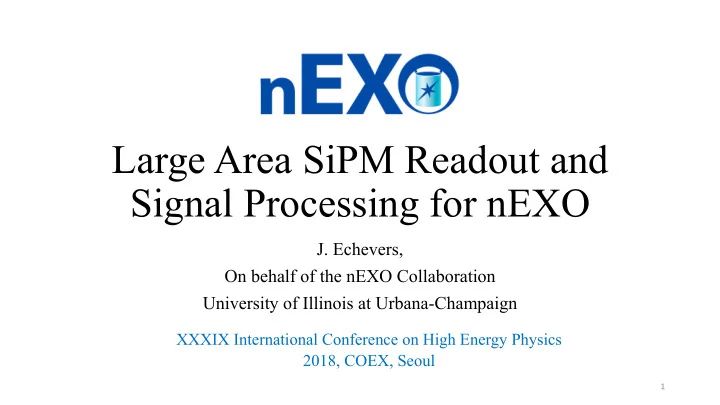

Large Area SiPM Readout and Signal Processing for nEXO J. Echevers, On behalf of the nEXO Collaboration University of Illinois at Urbana-Champaign XXXIX International Conference on High Energy Physics 2018, COEX, Seoul 1
Introduction to Neutrinoless Double-Beta Decay !/# > 10 #$ yr) is an active Search for neutrinoless double-beta decay (0 !"", $ field of research with important implications for nuclear and particle physics: • Unlike standard 2 !"" , no neutrinos are emitted • If it exists, it would imply BSM physics : neutrinos would have to be their own anti-particles (Majorana fermions), and lepton number would not be conserved 0 "## 2"## 2
The nEXO Experiment • A proposed 5-tonne liquid xenon (enriched 136 Xe) time projection chamber (TPC) to search for 0 !"" • Allows for 3-D tracking of events • Two primary signals from candidate events: scintillation ( VUV photons , # -coordinate) and ionization ( $% -coordinates) • Scintillation will be collected with silicon photomultipliers ( SiPMs ) and ionization with charge collection tiles • Resolution of energy deposited by candidate events is determined by light collection efficiency and charge collection efficiency Phys. Rev. C 97 , 065503 (2018) 3
Light Collection • Historically, photomultiplier tubes (PMTs) have been preferred as the choice light-collection device in similar experiments • Radioactivity of PMTs is too high for nEXO requirements • SiPMs are substantially less radioactive than PMTs • Large area avalanche photodiodes (LAAPDs) were used in the previous generation experiment, will be replaced by SiPMs in nEXO • In LAAPDs, the resolution is limited by electronics noise 4
Photo-detection efficiency Minimum nEXO requirement The efficiency of the low field (LF) FBK* devices tested exceeds the minimum requirements of nEXO and the optimal set point is near the beginning of the plateau. The colored bands represent the systematic uncertainties of the measurements. *FBK: Fondazione Bruno Kessler –an Italian SiPM manufacturer 5
SiPM Test Setup (U of Illinois, Indiana U.) • We tested a set of 6 FBK LF SiPM's (6 !" ! total area), in two configurations: A. All in parallel. All get the same # "#$% B. In a configuration of 3 in parallel, in series with another 3 in parallel. Equality of # "#$% is in this case forced by a resistor (thin film 42.9 M Ω ) in parallel with each group of 3. • Testing was done under very stable cryogenic conditions: 165 +/-0.1 K and % &'() +/- 0.01 V • Five of the SiPMs were covered, one exposed to a blue LED (same one in both configurations) 6x1 !" ! FBK SiPM Cryo-testing chamber SiPM readout board, designed Readout circuit diagram mounted on a ceramic carrier by ORNL (Oak Ridge National 6 board, 2.5 mW/channel Laboratory)
Single pulse waveform Unfiltered pulse After 3 MHz bandwidth filter V (V) V (V) 7
Unfiltered Waveforms 3 MHz bandwidth filter Correlated avalanches Dark noise (T<530 ns) (T>620 ns) Signal region (T ~530 ns -> 620 ns) 8
Resolution of pulse height spectrum (PHS) improves significantly in series configuration Parallel Series 1 P.E. 1 P.E. 2 P.E. R= 0.22 S.P.E R= 0.17 S.P.E 3 P.E. 2 P.E. 4 P.E. 3 P.E. … 4 P.E. … %#$&#% = 2! '($())#) *Note: ! !"#$ !"#$ 9
Resolution can be furthered improved with filtering Series Parallel R= 0.17 S.P.E R= 0.22 S.P.E R= 0.12 S.P.E R= 0.19 S.P.E 10
Results Series Parallel ! !"#$ (V) Unfiltered Filtered ! !"#$ (V) Unfiltered Filtered -single SiPM Resolution Resolution -single SiPM Resolution Resolution (SPE) (SPE) (SPE) (SPE) 5 0.17 0.12 5 0.22 0.19 4.5 0.2 0.13 4.5 0.24 0.21 4 0.2 0.14 4 0.26 0.23 3.5 0.19 0.15 3.5 0.29 0.25 11
Summary and conclusions • 0 !"" is an excellent decay mode to search for physics beyond the Standard Model • With nEXO we will be able to reach a 0 !"" search sensitivity close to # !/# = 10 28 years • Energy resolution is determined largely by photo-detection efficiency • The nEXO collaboration has undertaken a R&D campaign to test and characterize VUV-sensitive SiPMs • We have developed a baseline readout design for large area SiPMs • Single photoelectron resolution (important for energy resolution) in FBK SiPMs is best in series connection, as expected from theoretical predictions, however, radioactivity considerations (from added resistors) might be a concern • Next step is to fully develop an ASIC design for reading out the SiPMs 12
Acknowledgements • Research presented here was partially supported by the US Department of Energy (DOE) Office Nuclear Physics R&D program • Travel for this conference was made possible by the Alfred P. Sloan Foundation • We thank our nEXO Collaborators for discussions in the development of this work 13
Extra slide nEXO papers, describing the detector, the experiment’s sensitivity and some results from the R&D • “nEXOpCDR” arXiv:1805.11142 [physics.ins-det], May 2018 • "Sensitivity and Discovery Potential of nEXO to 0 νββ decay” Phys. Rev. C 97 , 065503 (2018) • "Characterization of an Ionization Readout Tile for nEXO“ J.Inst. 13 P01006 (2018) • "Characterization of Silicon Photomultipliers for nEXO“, IEEE Trans. NS 62, 1825 (2015) 14
Recommend
More recommend